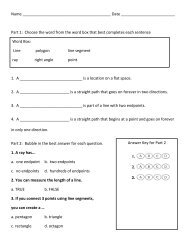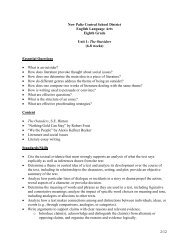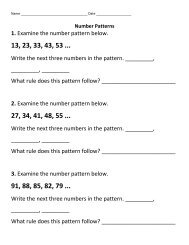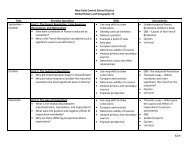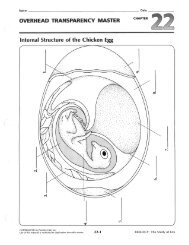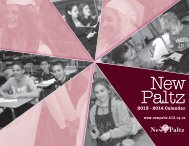Medieval Europe Quiz - New Paltz High School
Medieval Europe Quiz - New Paltz High School
Medieval Europe Quiz - New Paltz High School
- No tags were found...
Create successful ePaper yourself
Turn your PDF publications into a flip-book with our unique Google optimized e-Paper software.
Base your answers to questions 1 and 2 on<br />
the art work below and on your knowledge of social studies.<br />
1. With which historical setting is this art work most closely associated?<br />
A) India—Mughal Empire B) Japan—Tokugawa shogunate<br />
C) Middle East—Abbasid dynasty D) Western <strong>Europe</strong>—Middle Ages<br />
2. Which economic system is most closely associated with the activities shown in this art work?<br />
A) capitalism B) socialism C) manorialism D) communism
3. Base your answer to question on the chart below and on<br />
your knowledge of social studies.<br />
What is the best title for this chart?<br />
A) Knights' Code of Chivalry<br />
B) Role of the Church<br />
C) Feudal Obligations<br />
D) Rules for Guild Membership<br />
4. An economic reason for the institution of serfdom was to<br />
maintain<br />
A) religious uniformity<br />
B) an educated citizenry<br />
C) overseas trade<br />
D) a stable workforce<br />
5. In the <strong>Europe</strong>an feudal system under manorialism, what<br />
is the most significant economic commodity?<br />
A) sugar and spices B) land<br />
C) gold and silver D) livestock<br />
6. Which document established the principle of limited<br />
monarchy in England?<br />
A) Magna Carta B) Twelve Tables<br />
C) Act of Supremacy D) Balfour Declaration<br />
7. Which political system is best described in the outline<br />
below?<br />
8. Letting some farmland remain unplanted as a means of<br />
increasing food production is most closely associated<br />
with<br />
A) the three-field system<br />
B) the enclosure movement<br />
C) modern irrigation methods<br />
D) slash-and-burn agriculture<br />
9. In western <strong>Europe</strong>, feudalism developed after the<br />
A) Mongols invaded<br />
B) Roman Empire collapsed<br />
C) city of Constantinople fell<br />
D) Renaissance began<br />
10. The term feudalism is best defined as a<br />
A) system in which land is exchanged for military<br />
service and loyalty<br />
B) holy war between Christians and Muslims<br />
C) process in which goods are traded for other goods<br />
D) division of political power between three separate<br />
branches<br />
I. ________________________<br />
A. Decentralized government<br />
B. Based on loyalty and service<br />
C. Code of chivalry<br />
D. Military elite<br />
A) Oligarchy B) Democracy<br />
C) Absolutism D) Feudalism
11. Base your answer to the following question on Base your answer to the following question on the drawing<br />
below and on your knowledge of social studies.<br />
What inference can be drawn from the location of the church in this drawing?<br />
A) The church controlled trade within the manor.<br />
B) The church played a limited role in education.<br />
C) Religion played a significant role in the lives of the residents.<br />
D) The mill was managed by the church.<br />
12. The terms masters, apprentices, and journeymen are<br />
most closely associated with the<br />
A) encomienda system of Latin America.<br />
B) guild system of <strong>Europe</strong> in the Middle Ages.<br />
C) caste system of India.<br />
D) civil service system of China during the Tang<br />
dynasty.<br />
13. In western <strong>Europe</strong>, the Middle Ages began after the<br />
collapse of which empire?<br />
A) Roman B) Byzantine<br />
C) Ottoman D) Mughal<br />
14. Both <strong>Europe</strong>an medieval knights and Japanese samurai<br />
warriors pledged oaths of<br />
A) devotion to their nation-state<br />
B) allegiance to their families<br />
C) service to their church<br />
D) loyalty to their military leader<br />
15. During the feudal period in <strong>Europe</strong>, power and position<br />
in society were based on the<br />
A) level of education achieved<br />
B) amount of land possessed<br />
C) amount of money earned<br />
D) number of slaves owned
16. Which practice in medieval <strong>Europe</strong> was most similar to<br />
a Japanese warrior’s code of bushido?<br />
A) chivalry B) serfdom<br />
C) tribute D) indulgences<br />
17. Feudalism influenced <strong>Europe</strong> and Japan by<br />
A) encouraging formal education<br />
B) providing social stability<br />
C) fostering the growth of religion<br />
D) eliminating warfare<br />
Base your answers to questions 18 and 19 on the<br />
illustration below.<br />
18. This illustration suggests that the <strong>Europe</strong>an feudal<br />
system was<br />
A) designed to promote political and economic<br />
equality<br />
B) supported by the labor of the peasants<br />
C) controlled by a powerful middle class<br />
D) intended to provide opportunities for social<br />
mobility<br />
19. The illustration represents a society based on<br />
A) educational achievement<br />
B) political ability<br />
C) social class<br />
D) accumulated wealth<br />
21. The Middle Ages in Western <strong>Europe</strong> was characterized<br />
by<br />
A) decreased emphasis on religion in daily life<br />
B) absolute monarchies and strong central<br />
governments<br />
C) extensive trade with Asia and the Middle East<br />
D) the manor system and the importance of land<br />
ownership<br />
22. Which is a characteristic of a feudal society?<br />
A) rigid class structure<br />
B) industrial-based economy<br />
C) high literacy rate<br />
D) rapid social change<br />
23. Which was a characteristic of feudalism?<br />
A) Unified national court systems were developed.<br />
B) Power rested in the hands of a strong central<br />
government.<br />
C) Land was exchanged for military service and<br />
obligations.<br />
D) Government was provided by a bureaucracy of<br />
civil servants.<br />
24. In western <strong>Europe</strong> during the early Middle Ages,<br />
education declined as a direct result of the<br />
A) loss of the power of the Christian Church<br />
B) rediscovery of classical Greek civilization<br />
C) fall of the Roman Empire<br />
D) rise of absolute monarchs<br />
25. <strong>Medieval</strong> life in <strong>Europe</strong> was characterized by<br />
A) rejection of the teachings of the Christian church<br />
B) a thriving system of international trade<br />
C) limited social mobility<br />
D) a strong central government<br />
20. Which factor contributed to the decline in the power of<br />
the <strong>Europe</strong>an nobles in the late Middle Ages?<br />
A) collapse of international trade<br />
B) increase in the influence of serfs<br />
C) decreasing importance of towns and cities<br />
D) rise of nation-states
26. Base your answer to the following question on the<br />
illustration below and on your knowledge of social<br />
studies.<br />
In both <strong>Europe</strong> and Japan, the major reason for the<br />
development of the political system shown in the<br />
illustration was to<br />
A) increase trade and manufacturing in the region<br />
B) provide order during a period of weak central<br />
governments<br />
C) consolidate the political power of religious leaders<br />
D) eliminate the need for a legal system<br />
27. In <strong>Europe</strong>an feudal society, an individual's social status<br />
was generally determined by<br />
A) individual abilities<br />
B) education and training<br />
C) marriage<br />
D) birth<br />
28. Which economic system existed in <strong>Europe</strong> during the<br />
early Middle Ages?<br />
A) free market B) socialism<br />
C) command D) manorialism<br />
29. The growth of feudalism in <strong>Europe</strong> during the Middle<br />
Ages was primarily caused by the<br />
A) suppression of internationalism<br />
B) collapse of a strong central government<br />
C) decline of the Roman Catholic Church<br />
D) rivalry between the colonial empires<br />
30. Which statement about the social structure in <strong>Europe</strong><br />
during the Middle Ages is most accurate?<br />
A) The nobles encouraged social mobility.<br />
B) The practices of the Catholic Church led to the<br />
development of a classless society.<br />
C) Industrialization led to the growth of socialism<br />
throughout <strong>Europe</strong>.<br />
D) Sharp class distinctions divided <strong>Europe</strong>an society.<br />
31. One similarity between the feudal manors of <strong>Europe</strong><br />
and the traditional villages of India is that<br />
A) peasants were seldom able to change their social<br />
status<br />
B) women dominated the political decisions of the<br />
local councils<br />
C) children could choose from a number of different<br />
occupations<br />
D) monarchs exerted absolute power over local<br />
governments<br />
32. Which institution served as the primary unifying force<br />
in medieval western <strong>Europe</strong>?<br />
A) militar B) legislature<br />
C) church D) monarchy<br />
33. During the early Middle Ages, western <strong>Europe</strong>an<br />
societies were most influenced by<br />
A) elected parliaments<br />
B) national monarchies<br />
C) the Byzantine emperors<br />
D) the Roman Catholic Church
34. Base your answer to the following question on “The<br />
Peace of God declared that feudal warfare could not<br />
take place on church property, and it promised<br />
sanctuary in churches and abbeys to fugitives from<br />
combat. The Truce of God forbade fighting from<br />
Wednesday evening until Monday morning, on<br />
holidays, and during the religious seasons of Christmas<br />
and Lent. . . .”<br />
— <strong>Medieval</strong> and Early Modern Times<br />
This quotation implies that<br />
A) the church had considerable political power during<br />
this time.<br />
B) landlords determined when warfare took place<br />
C) war was limited to religious holidays<br />
D) religion was dictated by feudal law<br />
35. Which statement best describes the role of the Roman<br />
Catholic Church in <strong>Europe</strong> during the Middle Ages?<br />
A) The Church gained influence as people became<br />
more interested in secular affairs.<br />
B) The Church encouraged individuals to question<br />
authority.<br />
C) Church leaders were involved only in spiritual<br />
activities.<br />
D) The Church provided a sense of stability, unity,<br />
and order.<br />
36. The Roman Catholic Church during the Middle Ages in<br />
<strong>Europe</strong> can best be described as a church that<br />
A) favored separation from secular governments<br />
B) was a strong force that divided many people<br />
C) avoided involvement in social and educational<br />
matters<br />
D) was a stabilizing influence during a period of<br />
weak central governments<br />
37. Which statement best describes society under<br />
the influence of medieval Christianity and traditional<br />
Islam?<br />
A) Religion played a major role only in the lives of<br />
the clergy.<br />
B) Both religions influenced society by stressing the<br />
equality of all religions.<br />
C) Religion permitted the freedom to choose how<br />
people would worship.<br />
D) Religion was a way of life that governed people<br />
from birth to death.<br />
38. Rome during the Pax Romana and the Catholic Church<br />
during the Middle Ages are examples of<br />
A) centralized powers<br />
B) feudal governments<br />
C) Communist regimes<br />
D) constitutional monarchies<br />
39. Base your answer to the following question on Base<br />
your answer on the quotations below and on your<br />
knowledge of social studies.<br />
"The pope is the only person whose feet are kissed by<br />
all princes. His title is unique in the world. He may<br />
depose [remove] emperors."<br />
— Pope Gregory VII (llth century)<br />
"An emperor is subject to no one but to God and<br />
justice."<br />
— Frederick Barbarossa,<br />
Holy Roman Emperor (12th century)<br />
The ideas expressed in these quotations show that<br />
during the Middle Ages in <strong>Europe</strong><br />
A) monarchs dominated the Church's leaders<br />
B) monarchs and popes strengthened the role of the<br />
Church<br />
C) popes and monarchs sometimes challenged each<br />
other's authority<br />
D) popes gave little attention to political matters<br />
40. Which style of architecture is characterized by<br />
stained-glass windows, tall spires, flying buttresses, and<br />
pointed arches?<br />
A) Corinthian B) Gothic<br />
C) Ionic D) neoclassical<br />
41. The art, music, and philosophy of the medieval period<br />
in <strong>Europe</strong> generally dealt with<br />
A) human scientific achievements<br />
B) religious themes<br />
C) classic Greek and Roman subjects<br />
D) materialism
42. Notre Dame Cathedral in Paris, the Dome of the Rock<br />
in Jerusalem, and the Great Pyramid in Egypt are<br />
examples of<br />
A) architectural accomplishments that reflect<br />
religious beliefs<br />
B) ancient architectural monuments no longer in use<br />
C) the influence of cultural diffusion on<br />
contemporary architecture<br />
D) the influence of Buddhist architecture on<br />
conquered nations<br />
43. During the <strong>Europe</strong>an Middle Ages, guilds were created<br />
to<br />
A) regulate the money supply<br />
B) increase competition<br />
C) standardize goods and prices<br />
D) obtain better working conditions in factories<br />
44. Which period in <strong>Europe</strong>an history is most closely<br />
associated with the emergence of trade fairs, the<br />
founding of guilds, and the creation of the Hanseatic<br />
League?<br />
A) Age of Pericles<br />
B) Glorious Revolution<br />
C) Commercial Revolution<br />
D) Age of Reason<br />
45. In <strong>Europe</strong> during the Middle Ages, increases in trade<br />
and commerce resulted in<br />
A) increased political power for the clergy<br />
B) lower living standards for industrial workers<br />
C) decreased economic rivalry between kings<br />
D) development of towns and cities



